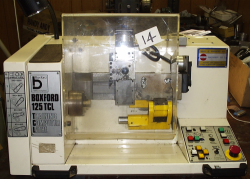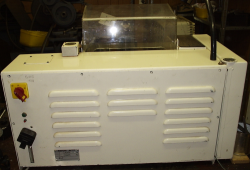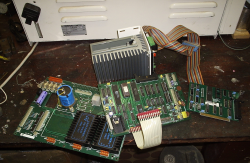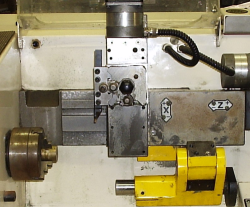
Fig-1 Boxford 125TCL Training Computer Lathe as purchased for $A350 - Front View.
The lathe is very clean having
done very little work but notice the control panel on the lower right,
this is not on the later models as it can get very dirty from coolant
splash and metal debris from the workpiece. Notice that this is a
'proper' industrial CNC lathe with the bed up on the vertical plane so
that turnings can fall away from the tool and workpiece, very nice!

Fig-2 Boxford 125TCL Training Computer Lathe as purchased for $A350 - Rear view.

Fig-3 Boxford 125TCL Training Computer Lathe after failed electronics have been removed.
From the top left you can see the cooling fan. In the middle top is the DC motor smoothing choke and top right is the DC spindle motor that provides a variable speed drive to the lathe's three jaw chuck. Bottom left is the main power isolator, fuses and overload circuit breaker. In the middle bottom is the control circuit power supply consisting of a 24 volt transformer, a bridge rectifier and to the bottom right is the control power supply smoothing capacitor that removes any ripple from the raw DC output.

Fig-4 Boxford 125TCL Training Computer Lathe showing failed electronics that were removed.
From Figure-4 you can see from
the left the axis power board which is burnt out. In the middle is the
Zilog Z80 based machine controller. At the right end is the ISA bus
communication card that slots into a PC to connect the PC to the lathe
along with it's 50 conductor IDC ribbon cable. In the middle top with
the finned alluminium extrusion is the variable speed drive
module that supplies the 150 volt DC spindle motor.

